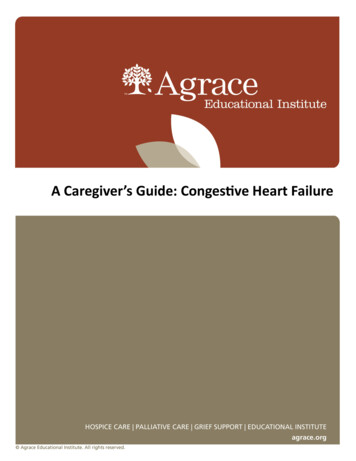
Transcription
A Caregiver’s Guide:Congestive Heart FailureA Caregiver’s Guide: Congestive Heart Failure321-3/15
A Caregiver’s Guide:Congestive Heart FailureThis is a guide and resource for family members, friends and other caregivers who aresupporting someone who has congestive heart failure (CHF).ContentsWhat is Congestive Heart Failure? . 1Heart failure over time . 2Focusing on comfortAnxiety . 3Confusion . 3Emotional health . 4Difficulty breathing and cough . 4Edema . 5Feeling tired and week .5Abdominal discomfort .6Difficulty sleeping .6Pain .7Skin care .7Implanted devices in the heart .8Heart failure emergencies . 10321-3/15
A Caregiver’s Guide:Congestive Heart FailureWhat is Congestive Heart Failure?In congestive heart failure, the heart cannot supply the body with adequate blood supply. This happensbecause the heart’s pumping power has been weakened due to damaged muscle. This could be caused byheart disease, heart attack, enlarged heart, high blood pressure, valve disease, thyroid disease, kidneydisease, diabetes, and certain birth defects in the heart. Often, people with heart failure have to beadmitted to the hospital or seen by a doctor for frequent medication changes.When someone has heart failure: Their blood moves through the heart and body at a slower rate, and pressure in the heart increases. Their heart begins to struggle to pump blood, causing oxygen and nutrient delivery to be impaired. Their heart may start stretching to hold more blood to pump through the body, or it may becomestiff. This helps keep blood flowing, but also weakens the heart and makes it less efficient. They might also have salt and water retention, which can cause fluid buildup in the body or lungs.Heart failure can be in the left side of the heart, the right side, or both. The chart below shows signs orsymptoms someone may experience, depending on where their heart failure is.Symptoms of Left-sided Heart FailureSymptoms of Right-sided Heart FailureFluid buildup in lungsFluid buildup in the bodyDifficulty breathing, fast breathingLow blood flow through kidneys, causing less urinationand fluid buildupDifficulty breathing while lying downSwelling in the body, weight gainDry, hacking or bloody coughNeeding to urinate more often at night, or less urinationLoud breathing sounds (wheezes)Nausea (related to bloating in stomach)Fast or irregular heart rateDecreased appetite (related to bloating in stomach)Anxiety, restlessness, confusionWeakness, low energyLow energy, tiredFluid buildup in abdomenBluish skin (related to low blood oxygenlevels), pale skinEnlarged/swollen neck veins, enlarged liver and spleenPage 1321-3/15
A Caregiver’s Guide:Congestive Heart FailureWhat is it like to have heart failure?During their illness, people with congestive heart failure (CHF) may have had multiple tests or procedures,such as X-rays, EKGs and stress tests. Some patients will have had surgery, valve repairs or replacements,pacemaker or defibrillator placement, or a heart transplant.Heart Failure Over TimeCongestive heart failure can be somewhat stable at first, and may only require routine check-ups with adoctor. In the next stages, people might need more support and hospitalizations. There can be ups anddowns, with a general worsening of the disease and symptoms over time. The last stage of decline canlast from days to weeks. Even so, death can be unexpected due to earlier patterns of the persongetting worse, then better. People often believe they can “get through” one more time as they havedone before.Things to know: It is very hard to predict how someone with heart failure will decline over time. 35 to 45 percent of people with heart failure experience sudden death.Medical management of people with heart failure can include: Treating and monitoring fluid build-up based on weight (an increase in weight might point towardincreased fluid build-up). Using medications and treatments to manage symptoms of the disease. One commonly usedmedication is a diuretic, which acts by getting rid of extra fluid.Focusing on ComfortPeople with heart failure may have a number of uncomfortable issues. Here are some of them, includingways to help someone who is suffering from heart failure.Page 2321-3/15
A Caregiver’s Guide:Congestive Heart FailureAnxiety:Thirty percent of patients with heart failure experience some form of anxiety. If they are able to respond, ask if they are feeling anxious or restless. Ask them what is making them feel anxious– treating the issue or symptom can help. Ask them what has helped when they have felt anxious in the past. Offer support and reassurance.Suggestions for care: Try simple breathing techniques, distraction, or guided imagery. Use medications for anxiety that have been ordered by their doctor.ConfusionThere are many possible causes of confusion in people with heart failure. They might have low oxygenlevels, symptoms may be getting worse, or they could be reacting to new or changed medications.Suggestions for care: Use basic reminders to re-orient them: “You are at home and today is Wednesday.” Keep their room well-lit room with familiar objects, a visible clock and calendar. Try to limit noise. Consider medications that have been ordered by the doctor for confusion Remember that the presence of familiar faces and voices can calm them. Ask your Agrace team about other ideas or support.Remember: If someone with heart failure has unexpected changes and you are concerned about their safety, callyour Agrace team for help. Sometimes we can find the cause of the confusion and work to treat it; however, the symptomscould be caused by worsening disease, making it more difficult to treat.Page 3321-3/15
A Caregiver’s Guide:Congestive Heart FailureEmotional Health: Depression, anger, guilt, and thoughts of suicidePeople with heart failure often come to a point where they have found a way to live with the ups anddowns of the disease. As with other illnesses, there can be a financial burden with building medical costs.And, there may be a belief that there is always something more that can be done; the “ups and downs”can make them think that they will recover again.Depression is common in people with heart failure (up to 59 percent). In addition to depression, patientscan experience despair, anger, regret, guilt and thoughts of suicide.Suggestions for Care: Encourage the patient to talk through their feelings. Sharing their experience with others canbe helpful. Consider talking with the hospice team about medications for depression.Difficulty Breathing and CoughOne study suggests that 61 percent of people with heart failure have shortness of breath. When the leftside of the heart doesn’t pump the way it should, fluid collects in the lungs they can’t expand to letenough air in. Breathing gets harder, and the person may feel short of breath, especially when they aremoving around or lying down flat.Suggestions for care: Be calm. Reassure them. Consider using oxygen. Try breathing techniques, such as pursed-lips breathing: Tell the person to breathe deeply throughtheir nose (“smell the flowers”) and exhale through pursed lips (“blow out the candle”). Keep the room cool. Warm air can “feel” heavier. Cool air from a fan directed at the face can make people feel like they are breathing easier. Help them find ways to conserve their energy. Is getting up to the bathroom exhausting?Consider putting a commode beside of the bed. Talk to your hospice team about other ways toconserve energy. Reclining can make breathing harder for people with heart failure. Lift the head of the bed or propthem on pillows. Helping them to lean forward with their elbows on a table might help, also.Page 4321-3/15
A Caregiver’s Guide:Congestive Heart Failure Talk with the hospice team about the patient’s medications. Are they working the way they should?Do they need to be changed or increased? If the patient has a cough, cough medications can be helpful. Morphine can make them feel like they don’t have to work as hard to catch their breath. Giving their breathing medications before they move can help them better tolerate activity. If the patient is having difficulty breathing that continues to get worse, call your hospice team.Edema (Fluid Build-up)When the right side of the heart isn’t working well, fluid can collect in the feet and lower legs. Puffy legsare a sign of right-side heart failure, especially if you can press on the area and a dent or “pit” remains. Asright-sided heart failure gets worse, the upper legs, genital area and abdomen can begin to collect fluid.The patient might also gain weight from the fluid that accumulates.Suggestions for care: Limit the amount of fluid or salty food the person drinks and eats. If they take in extra fluid or saltyfoods (foods with high sodium), their swelling could get worse and they could become uncomfortable. Talk to the Agrace team about diuretics—medications that can help the body get rid of extra fluid. Ask your Agrace team about other options for fluid removal that could help reduce swelling in thepatient’s abdomen. If fluid appears to be “leaking” from the areas of their body that are swollen, use absorbent towels tocatch the fluid. Change the towels as necessary to keep their bed dry. Be careful to prevent falls: People who have a lot of swelling are more likely to fall, as movementbecomes awkward. Elevate the patient’s legs if swelling is uncomfortable. When legs are elevated (if patient is lying downor in a recliner), they might urinate more often.Feeling Tired and WeakFeeling tired or weak has a big effect on the lives of people with heart failure. This can be caused by thingslike infection, dehydration and depression. If we cannot completely treat the cause, caregivers can supportpatients in other ways.Page 5321-3/15
A Caregiver’s Guide:Congestive Heart FailureSuggestions for care: Encourage them to avoid “overdoing it” and help them find ways to conserve energy. Help them set limits: Find out what times of the day they have the most energy, and plan activitiesduring that time. Ask about their goals. If getting clean and dressed drains their energy and prevents them from doingthings that are important to them, it might be helpful to find help for them in those areas. Work with your hospice team to find ways volunteers or nursing assistants could help the personconserve energy.Abdominal DiscomfortSome people with CHF feel sick to their stomach because they have abdominal swelling, an enlarged liveror slow-moving bowels. Others find that they have less appetite, or that food doesn’t taste the way it didbefore. As a caregiver, you may find them wanting to eat less. It is important to look for ways to manageand treat these issues if we can.Suggestions for care: Offer small, frequent meals. Encourage the person to eat slowly. Suggest that they sit up at least an hour after eating. Talk with your hospice team about medications that can help with slow bowels, which can lead toconstipation and nausea. If the patient is using morphine or other narcotic, be sure they use a stoolsoftener and/or laxative to prevent constipation.Difficulty SleepingAccording to one study, 45 percent of patients with heart failure have difficulty sleeping. Trouble withbreathing, stress, worry, fear of dying during sleep, and getting up to use the bathroom can all causesleep problems.Suggestions: Sometimes elevating the head of the bed can help. Try using a fan or oxygen to make breathing easier.Page 6321-3/15
A Caregiver’s Guide:Congestive Heart Failure Consider placing a commode or hand-held urinal next to the bed so they don't have to leave the roomto go to the bathroom at night. Talk to your Agrace team about the timing of the patient’s medications, because changing the timecan have an effect on sleep. Medications that make them sleepy could be given later in the day.If diuretics are given before bed, they might be getting up to the bathroom more often at night.PainStudies show that up to 78 percent of patients with heart failure have pain at some time or another.Some have pain in their chest. Others might feel stretching pain from their enlarged liver. There could alsobe pain that patients have had all their lives, like back pain or arthritis, which could get worse when combined with other heart failure symptoms. Whatever the cause, it is important to find ways to manage andtreat any pain the patient might be feeling.Suggestions for care: Work with the patient to keep them comfortable on their own terms. Is it OK with them if they feel alittle sleepy after taking pain medication? As you are caring for the patient, watch for signs of pain. Does their forehead wrinkle when they move?Are they holding their chest or abdomen? These signs can help us figure out what is bothering them. If the pain is due to swelling, diuretics can help get rid of extra fluid. Narcotics like morphine or oxycodone can help with both pain and shortness of breath. Tell your hospice team if you don’t feel able to give the medications the patient needs to staycomfortable. The team can work with you to come up with a plan.SkinSwelling, along with moving less and eating less, can put patients at risk for skin injury. Areas that are mostlikely to break down due to pressure or friction are the legs, heels, elbows and bottom. Wounds andinjuries can lead to pain or infections; this can happen quickly and easily. For this reason, we closely watchfor signs of skin breakdown and step in quickly to care for them if we see problems.Suggestions for care (these are also found in the Agrace Patient & Family Care Handbook): Watch daily for signs or risks of skin breakdown: reddened areas that do not fade open areas or blisters on the skinPage 7321-3/15
A Caregiver’s Guide:Congestive Heart Failure a worsening of any open area of skin any changes in the patient’s ability to turn or change positionTo keep the skin healthy: Wash with warm water and mild soap. Avoid friction or rubbing. Clean the skin after each soiling. Use alcohol-free lotions to moisturize dry skin. Do not massage reddened areas. Apply moisture barrier creams or ointments to fragile skin that comes in contact with moisture. Raise heels off of the bed by placing pillows under calves and knees for support. Change position at least every two hours while in bed and every one hour if sitting up in a chair. Keep the angle of the head of the bed at less than 30 degrees when not eating or drinking. Remove restrictive clothing, such as TED stockings, to allow the skin to breathe. Use pillows between the ankles and knees, behind the back, under elbows, and under calves tofloat heels. Pillows protect these bony parts of the body from extended periods of pressure.Use towels or gauze to keep the skin clean and dry if you notice any leaking fluid. Your hospice teamwill help you with this.Implanted Devices in the HeartImplantable cardioverter defibrillator (ICD): This small device is placed in the chest or abdomen and isused to help treat irregular heartbeats or rhythms. An ICD uses electrical pulses or shocks to helpcontrol life-threatening arrhythmias, especially those that can cause sudden cardiac arrests.Ventricular assist device (VAD): This mechanical pump is used to support heart function and blood flow inpeople who have weakened hearts. The VAD takes blood from a lower chamber of the heart and helpspump it to the body.Pacemaker: A pacemaker is a small device placed in the chest or abdomen to help control abnormal heartrhythms. It uses electrical pulses to “tell” the heart to beat at a normal rate. Worldwide, about 3 millionpeople have pacemakers.Page 8321-3/15
A Caregiver’s Guide:Congestive Heart FailureCan it be turned off?All of these devices can be turned off, but caregivers and patients should talk to their doctor, family andhospice team about any issues related to end-of-life. For example, if someone has a pacemaker andbecomes ill with a condition that isn’t related to how the heart works, it’s possible the pacemaker couldmake the dying process longer.Should it be turned off?ICD: Many patients have their ICD turned off when their goal changes from living longer (aggressivetreatment) to getting the most comfort possible at end of life (allowing for a natural death).VAD: The decision to deactivate a VAD is similar to the decision to withdraw a ventilator. See the“How is it turned off?” section below for more information.Pacemakers: Usually, pacemakers do not need to be turned in end-of-life situations unless the patient orfamily requests it, which usually happens if they feel the device is making the dying process longer. If apatient heart is dependent on the pacemaker, then death may occur within days of deactivation. In mostsituations, deactivation is not recommended since it could lead to a very low heart rate (which can causetiredness, dizziness and difficulty breathing). It would be rare to turn off a pacemaker and have someoneexperience a quick death, as few patients rely on their pacemaker 100%, especially during the dyingprocess. Pacemakers do not keep dying patients alive.How is it turned off?ICD: Turning off an ICD is not difficult. Usually the vendor will re-program a computer to reset the device.This will not cause death. It will not make the patient feel worse. If the patient were to have a lifethreatening heart rhythm after it is turned off, it will not deliver a shock.VAD: A VAD is turned off in a similar way to an ICD; however, VADs also have an external power sourceand controlling unit, which makes turning it off similar to removing a ventilator. There should be a plan inplace to manage any breathing difficulties, agitation or discomfort that could occur after the device isturned off. Patients and families should be prepared for death to occur in a range from a few minutes to afew days.Pacemaker: Some pacemakers can be deactivated with a large magnet. However, newer pacemakerscannot be turned off without a cardiologist.Page 9321-3/15
A Caregiver’s Guide:Congestive Heart FailureHeart Failure EmergenciesIt is important to know that with heart failure, there is a possibility of life-threatening emergencies. Yourhospice team will work with you to help prepare you for things that might happen. If you ever have aconcern about a symptom that is getting worse, we always encourage you to call Agrace first for help.Sometimes, a nurse can come to your home and provide care, or we can help arrange for transfer to oneof Agrace’s inpatient units.Flash Pulmonary EdemaFlash pulmonary edema, or a sudden, excessive buildup of fluid in the lungs, can lead to the patient feeling like they can’t breathe. The patient may cough up pink, bubbly spit and become sweaty or “clammy”.They might also feel confused or have pain in their chest. This can be distressing for both the patient andcaregivers. Work with your hospice team to talk through ways to prepare for the possibility of this heartfailure emergency.If you notice a worsening of any of the symptoms below, we encourage you to call Agrace: Difficulty breathing Using oxygen can help the patient breathe more easily. Remember the importance of position changes and breath coaching (See Difficulty Breathingsection for reminders.). Narcotic medications can work to quickly ease the work of breathing. Your hospice team mightrecommend having IV access available so the medication can be given into the vein quickly.Seizures Medications that help with anxiety (like Lorazepam) should be quickly available. Again, thehospice team might recommend intra-venous (IV) access for quick relief. Seizure safety: Position the person on their side to prevent choking if they drool or vomit. Move them away from sharp objects, ledges, etc. Loosen tight clothing; do not restrain them. Place something soft under their head. Stay calm; comfort and reassure the patient.Page 10321-3/15
In congestive heart failure, the heart cannot supply the body with adequate blood supply. This happens because the heart's pumping power has been weakened due to damaged muscle. This could be caused by heart disease, heart attack, enlarged heart, high blood pressure, valve disease, thyroid disease, kidney










